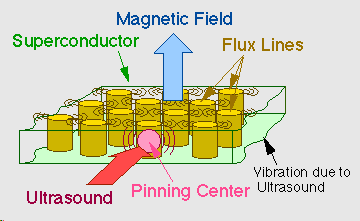Ultrasonic Study of Superconducting Mixed State
Jump to [Background] [Feature] [Prospects]
- [Background]
- When an electric current is flowed in the state that quantized flux lines go through
a type II superconductor (mixed state),
flux lines are forced to move by a Lorentz force,
and a voltage is induced in the sample.
However, if impurities or deficiencies are included in the crystal,
flux lines are "pinned" by them, and the induction of voltage is suppressed by the pinning.
Such impurities or deficiencies are called as "pinning centers".
In high temperature superconductors, the effect of thermal excitation on the flux pinning is large, while the superconductivity appears at high temperatures. In particular in Bi-compounds, a resistance appears even at the temperature much lower than the superconducting transition temperature (Tc). This is a serious problem in view of the application of high temperature superconductors. Therefore, it is valuable to know what kinds of deficiencies are effective for the pinning centers in the utilization at high temperatures and high magnetic fields.
So far, the flux pinning properties have been examined by the measurements of critical current and magnetization. However, we are using an ultrasonic method in this study, as will be mentioned below.
- Fig.1. Interaction between ultrasound and magnetic flux lines
- If flux lines are pinned, the flux line lattice is vibrated by the ultrasound propagating in the superconductor due to the coupling with pinning centers. (The figure shows the case of transverse ultrasound)

by@Y. Horie
